Robin Westman YouTube Video and Minneapolis Shooting
On a quiet Wednesday morning, the sanctuary of Annunciation Catholic Church in Minneapolis became the scene of unspeakable violence. A gunman opened fire during Mass, killing two children and injuring 17 others before taking his own life. Authorities quickly identified the shooter as 23-year-old Robin Westman, a former student of the parish school, whose disturbing online presence offered chilling insight into the mindset behind the massacre.
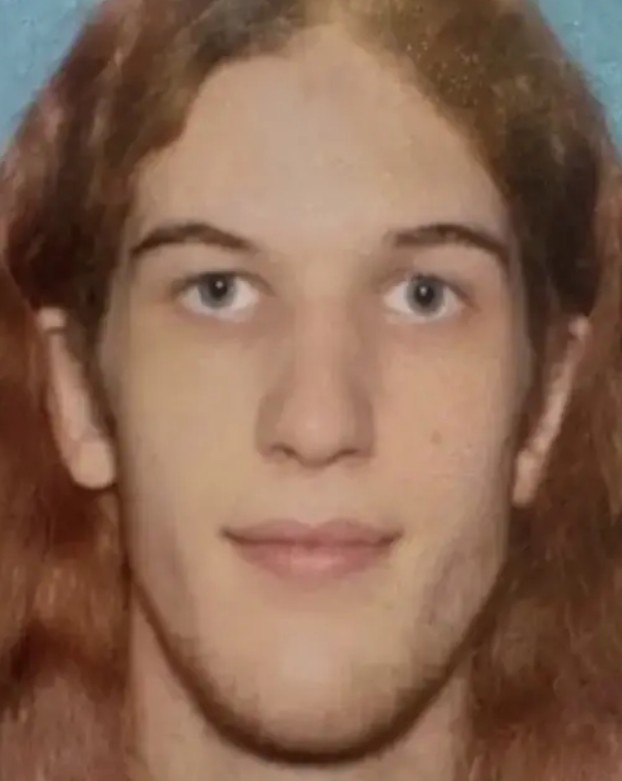
Investigators now believe a series of bizarre videos and a rambling manifesto posted online by the suspect may hold the key to understanding what drove this act of devastation.
Contents
- 1 The Attack at Annunciation Catholic Church and Full Video
- 2 Identity of the Suspect: Robin Westman
- 3 The Online Videos and Manifesto
- 4 Disturbing Messages on Weapons
- 5 Obsession with Mass Shooters and Online Subcultures
- 6 Family and Community Reaction
- 7 Law Enforcement and Investigative Focus
- 8 Broader Implications
The Attack at Annunciation Catholic Church and Full Video
The tragedy began just as parishioners gathered for morning worship. What should have been a serene service turned into chaos when gunfire erupted inside the church. Worshippers scrambled for cover as the shooter fired indiscriminately. Two children lost their lives, while 17 others sustained injuries ranging from minor to severe.
Robin Westman’s video talking about the upcoming act
robin-westman-youtube-video.mp4
Full uncensored video of Robin Westman is truly terrifying
robin-westman-youtube-video-1.mp4
robin-westman-youtube-video-2.mp4
By the time police arrived, the attacker had already died from a self-inflicted wound. Minneapolis Police Chief Brian O’Hara later confirmed the suspect’s identity and spoke of the investigation into the disturbing digital materials linked to the attack.
The church community, which had nurtured families for generations, was left reeling. The fact that the gunman himself had once been a student of Annunciation made the assault even more painful.
Identity of the Suspect: Robin Westman
Public records reveal a complex personal history. Born Robert Paul Westman, the suspect graduated from Annunciation grade school in 2017 before briefly attending Minnesota Transitions Charter School later that year.

In 2019, Westman’s mother petitioned to legally change her child’s name, explaining that Robin identified as female. A judge approved the change in January 2020, writing that the petitioner “identifies as a female and wants her name to reflect that identification.”
Westman lived with her father less than a mile from the church. Neighbors described the parents as generous and kind. Jim White, who lived across the street, remembered how the Westmans had once donated hundreds of cement blocks to help with his garden project. “They are very nice neighbors, very good people,” he said.
Despite the family’s positive reputation, many neighbors said they rarely saw Robin. One longtime resident admitted he could not recall ever speaking with the young adult who would later carry out one of the most shocking acts in the neighborhood’s history.
The Online Videos and Manifesto
Shortly before the attack, several unsettling videos appeared on YouTube under the name “Robin W.” Police are now working to authenticate the materials, though the timing and content strongly suggest they were linked to Westman.

The videos showed a handwritten notebook filled with disturbing messages. The suspect displayed an arsenal of firearms, magazines, and ammunition laid out on a bed. One target bore the image of Jesus.
The notebook itself mixed English writing with Cyrillic script and some Russian words. Within its pages, Westman expressed overwhelming self-loathing and a fixation on death. On one page, the words “I’m so sorry” were scrawled in large letters. While filming, the person whispered, “I love my family,” and later admitted, “I don’t know what else to say.”
Perhaps most chilling was a hand-drawn diagram of the interior of Annunciation Church. In the video, the person stabbed a knife into the drawing, laughing and muttering, “ha, nice.”
Disturbing Messages on Weapons
Investigators revealed that many of the firearms shown in the videos had been painted with hateful slogans and extremist references. Phrases such as “psycho killer” and “suck on this!” were visible.
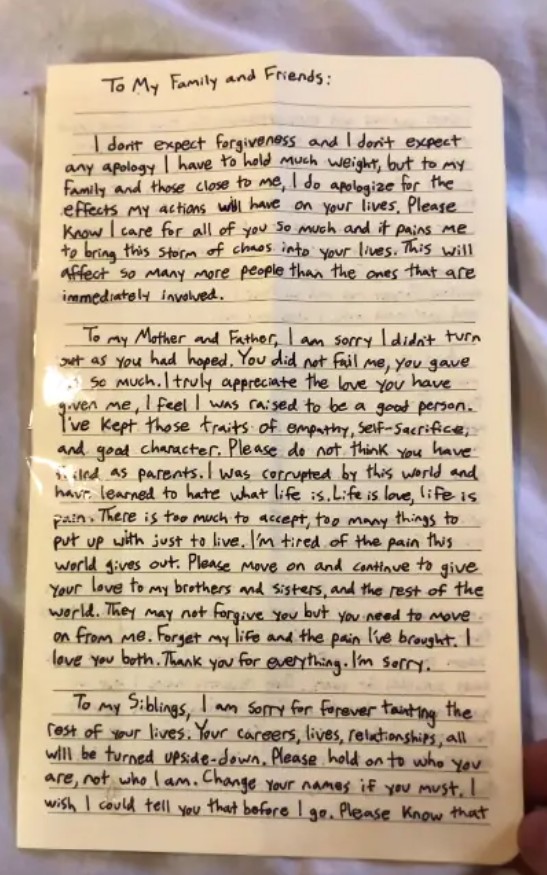
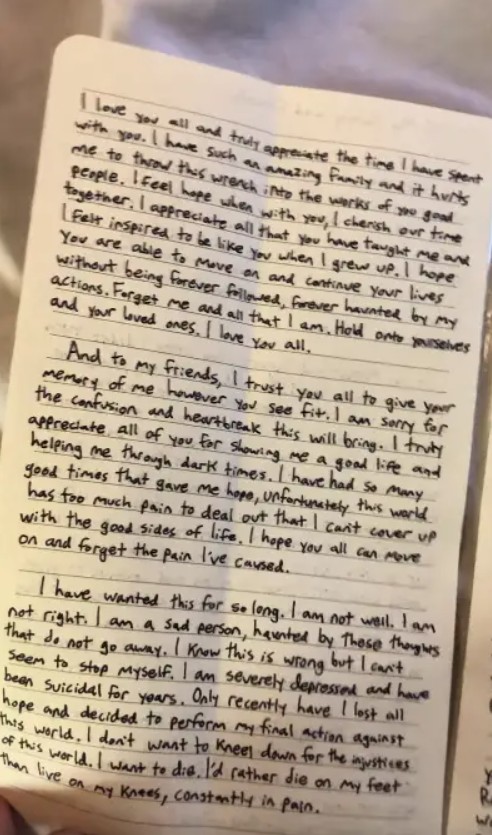
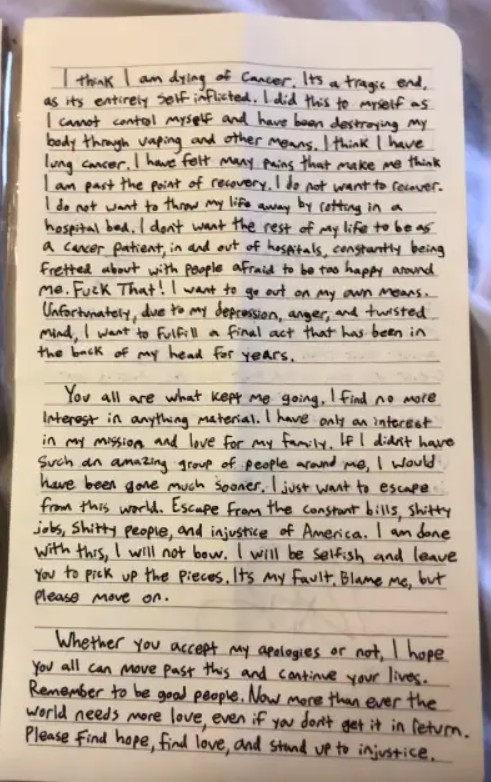
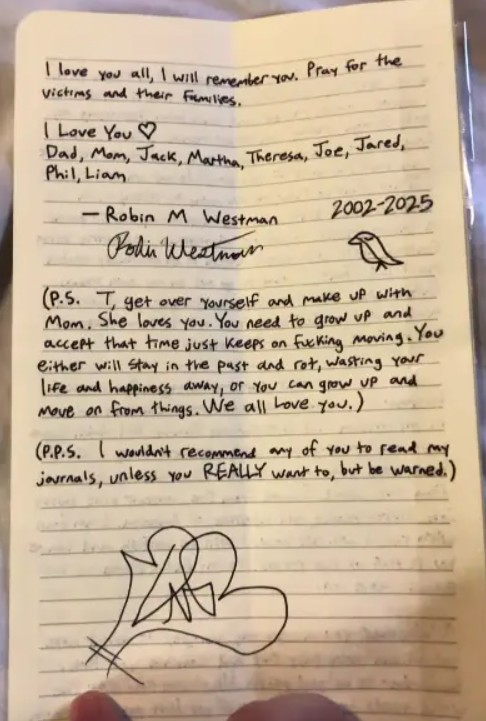
Antisemitic statements were also scrawled on the weapons, including the chilling phrase “6 million wasn’t enough.” Another magazine bore the message “kill Donald Trump.”
Several of the weapons listed the names of infamous mass shooters, including Adam Lanza, who killed 26 people at Sandy Hook Elementary School in 2012, and Robert Bowers, who murdered 11 people in a Pittsburgh synagogue in 2018. These markings suggested that Westman saw himself as part of a dark lineage of killers.
Obsession with Mass Shooters and Online Subcultures
The notebook confirmed what experts describe as a “morbid obsession” with mass violence. Westman openly wrote about admiration for Adam Lanza and other shooters, admitting to becoming fixated on their actions from a young age.
Cody Zoschak of the Institute for Strategic Dialogue, a research group tracking extremism, said Westman’s writings resembled those of Solomon Henderson, who earlier this year killed a classmate in Nashville before taking his own life. Henderson’s manifesto also mixed nihilistic rambling with extremist references and trolling attempts.
This pattern points to a broader online culture where violence is glorified and past killers are idolized. Individuals immersed in such communities often leave behind digital traces videos, manifestos, and symbols designed both to shock and to secure notoriety.
Family and Community Reaction
While authorities studied the videos, the suspect’s parents were left in visible anguish. Neighbors saw Robin’s father and another woman sitting in stunned silence outside their home as officers searched the property.
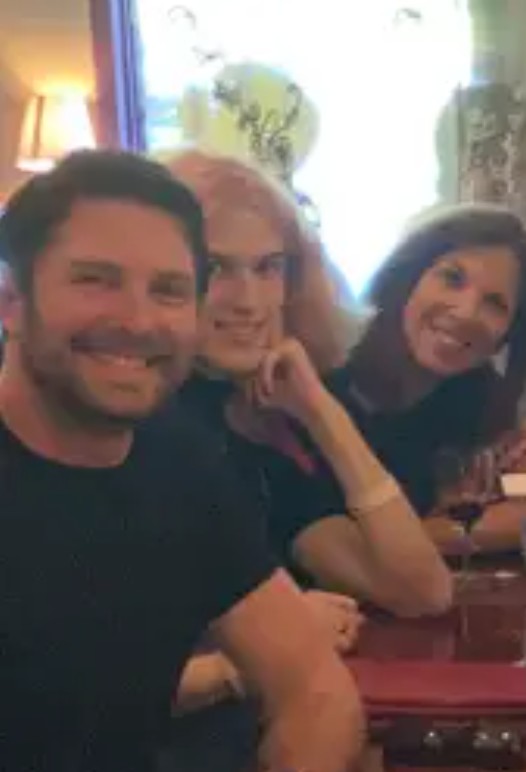 “They are a wonderful couple a good part of this neighborhood,” said Terry Cole, who struggled to hold back tears. “People take care of each other here. It’s just such an absolute shock.”
“They are a wonderful couple a good part of this neighborhood,” said Terry Cole, who struggled to hold back tears. “People take care of each other here. It’s just such an absolute shock.”
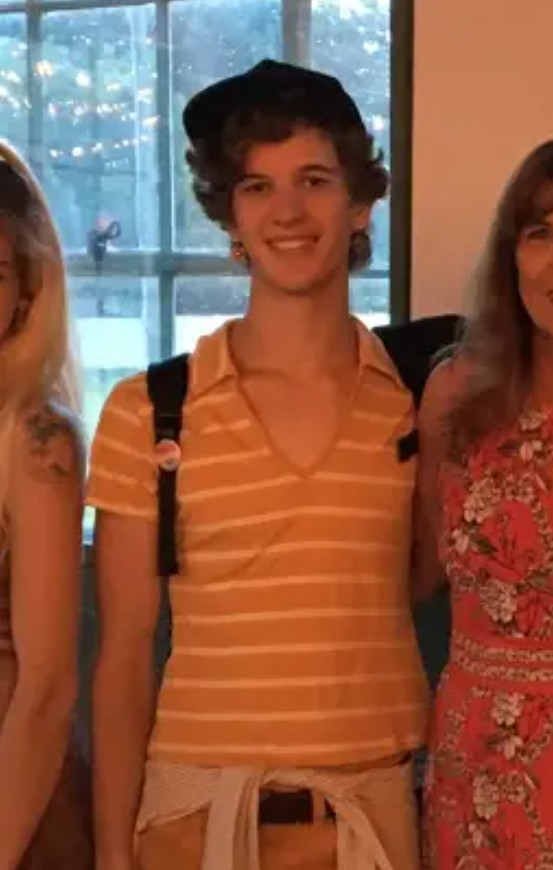
The family’s ties to Annunciation deepened the sense of betrayal. Robin’s mother had worked at the school from 2016 to 2021, and many parishioners remembered her warmly. Now, the community faced not only the loss of two young lives but also the pain of knowing that one of their own had turned on them in such a violent way.
Law Enforcement and Investigative Focus
Chief O’Hara confirmed that federal and local investigators are working together to review the manifesto and videos. Authorities hope the writings may provide insight into Westman’s mindset and potential warning signs.
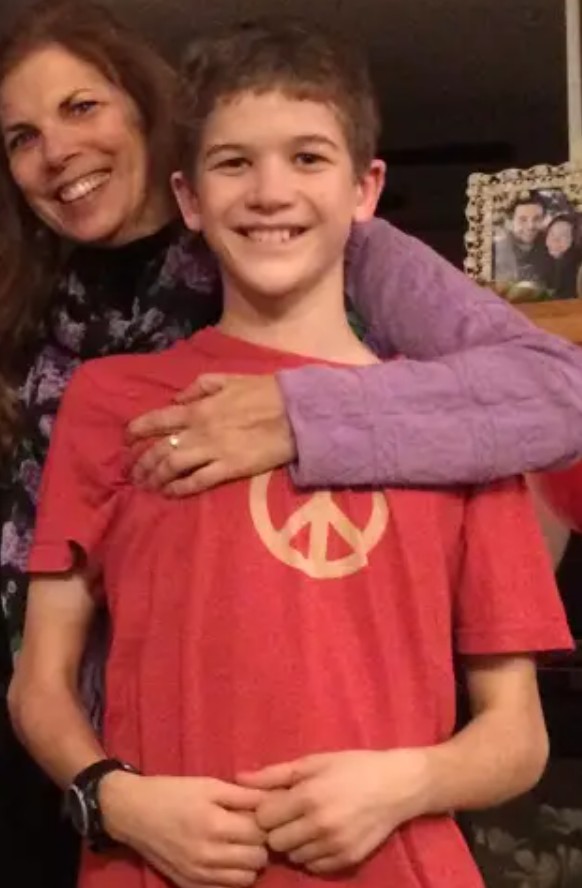
At present, investigators believe the attack was not explicitly driven by political or racial ideology, despite the hateful imagery and slogans. Instead, the writings suggest a fragmented motive rooted in personal despair and fascination with past shooters. One entry declared: “In regards to my motivation behind the attack I can’t really put my finger on a specific purpose… I do it to please myself. I do it because I am sick.”
Authorities are also examining whether Westman interacted with online extremist communities and whether those influences played a role in shaping the attack.
Broader Implications
The Minneapolis church shooting highlights the increasingly complex role of online platforms in modern acts of violence. Shooters often leave behind digital artifacts that serve both as personal expression and as tools for notoriety. While such content can aid investigations, it also risks fueling copycat behavior.
Experts warn that the fusion of personal struggles, extremist ideology, and internet subcultures creates a dangerous environment. Individuals like Westman may not fit neatly into categories of terrorist or ideologically motivated attacker. Instead, their actions emerge from a toxic blend of self-hatred, fascination with violence, and access to online communities that glorify mass killers.
The case also raises questions about how communities, schools, and families can recognize warning signs before tragedy strikes. Westman’s contradictions expressions of love for family alongside hatred for humanity reflect the complex mental state of someone spiraling into violence.
The massacre at Annunciation Catholic Church left Minneapolis in mourning. Two children lost their lives, 17 others were wounded, and countless families were traumatized. The shooter, Robin Westman, left behind a digital trail that revealed an obsession with mass violence, extremist imagery, and self-destruction.
As investigators continue to analyze the manifesto and videos, one truth remains painfully clear: the dangerous interplay of online radicalization, personal despair, and access to deadly weapons can have devastating consequences.
For the Annunciation community, the path forward will be one of grief and healing. For the wider public, the tragedy is a stark reminder of the urgent need to confront the spread of extremist online subcultures and to strengthen efforts at prevention.
Daily News -Pontus Rasmusson of Bunny Video and Influencer Responsibility
Bonnie Blue Petting Zoo Video and Fall of an Extreme
Ari Kytsya Starbucks Video Original and Internet Frenzy
Alana Flores Video and Lessons from Digital Culture
Daisy Melanin Viral Video and Divides Public Opinion
Orhan Erdemir and Elif Karaarslan Video Incident
Baltasar Ebang Engonga Video and Controversy Scandal

